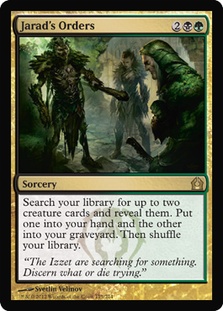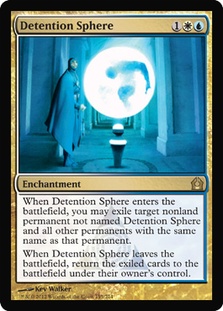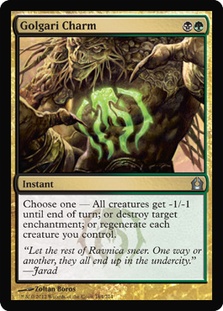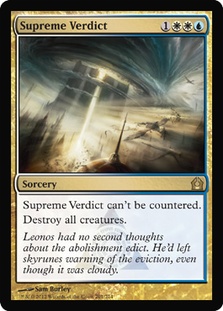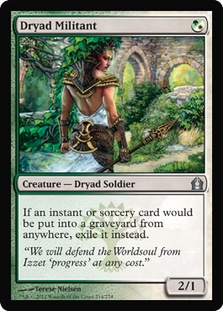Ravnica block set a high bar for its inevitable return. Blazing Archon, Dark Confidant, Flame-Kin Zealot, Remand, and every single card with dredge 2 or more has seen play in Legacy over its seven year lifespan. The story of Ravnica: City of Guilds was one of Golgari dominating on a mechanic level—Flame-Kin Zealot has seen play only in decks with Golgari Grave-Troll, and neither card was played with any intention of paying mana for the card in question.
I hate to disappoint those of you hoping for a different narrative with Return to Ravnica, but the Golgari look to have the best Legacy cards yet again. If you believe that, on a fundamental level, set reviews are about telling people what cards are worth playing and what cards are worth buying, here are my headlines:
Every top tier deck except for RUG Delver gets something, but Return to Ravnica will not fundamentally change the format.
Bayou is the Legacy card that will increase the most in price now that Return to Ravnica is legal.
It’s impossible to ignore how good the Golgari cards are. Let’s start with the two that excite me the most:
Jarad’s Orders and Deathrite Shaman
When I first saw Jarad’s Orders, I thought of Patrick Chapin Survival of the Fittest deck from GP Columbus 2010—specifically, his innovation of Loyal Retainers + Emrakul, the Aeons Torn. Of course Orders is nowhere close to the level of Survival, but it is an Entomb stapled to an Eladamri’s Call, both of which have seen play in this format. The most intuitive way to use this card, then, is as a stapled-together Entomb / Exhume, so my first build borrows heavily from his Aether Vial on three + Loyal Retainers + Emrakul, the Aeons Torn model:
Creatures (21)
- 4 Birds of Paradise
- 1 Bone Shredder
- 1 Loyal Retainers
- 4 Mesmeric Fiend
- 1 Knight of the Reliquary
- 1 Iona, Shield of Emeria
- 1 Emrakul, the Aeons Torn
- 4 Fauna Shaman
- 4 Deathrite Shaman
Lands (20)
Spells (19)

For where I got my inspiration, go here. There’s a lot to learn from that article about maximizing value in deckbuilding. I’m very confident that this is nowhere close to the best possible version of the deck, but I wanted to get in a reference to the model so that we know what we’re aspiring to. Let’s break this thing down. First, our strategy.
We’re a combo deck. We’re definitely not the fastest combo deck out there, but we’re a combo deck. We try to have answers to as broad a range of faster threats as possible. I mean, we’re never beating any four-mana spell cast off of a Pyretic Ritual, but no deck with a Savannah ever does. Thankfully for us, there are plenty of other people keeping those jokers in check. For everything else, there’s disruption:
Show and Tell? Activate Vial, Mesmeric Fiend you in response.
Entomb? I have this Deathrite Shaman, bro. You sure you wanna do that?
A ton of countermagic, Stifles, and Spell Pierces? Fauna Shaman for Mesmeric Fiend after Mesmeric Fiend, Vial all of them in, Cabal Therapy you a bunch, then get Knight of the Reliquary to get Volrath’s Stronghold if you have anything left. Then, you know, resolve Jarad’s Orders and kill you.
Playing some durdly value deck? Jarad’s Orders for Loyal Retainers and Emrakul. Reshuffle trigger on the stack, Vial in Retainers and sacrifice it, targeting Emrakul. Shuffle in my Loyal Retainers for later use.
Playing burn? Same thing as before, but with Iona, Shield of Emeria. Also, Deathrite Shaman has an effect attached to that pesky “cost” of Cremating a creature. Who knew??
In short, we’re playing a one-card kill backed up by a ton of disruption. Let’s talk about the specific card choices. Since this is a set review, newcomers first:
4 Deathrite Shaman: The vast majority of the time, this is going to be a Birds of Paradise. In order to have Shaman in full Birds of Paradise mode, we’ll need to play more than the standard six-to-eight fetchlands that typify Legacy mana bases. More on that later, but it’s worth keeping an eye on.
The other two abilities are both useful. The green one will come up a good amount of the time against Dredge, Reanimator, Burn, RUG, and Rector-Omniscience, while the black one will occasionally hose a Snapcaster Mage, Nimble Mongoose with exactly threshold, a Lingering Souls, or a sloppy Storm player that needs their Past in Flames to rebuy a specific Tutor.
I don’t think this is better than Noble Hierarch in aggressive decks. I do think this is better than Birds of Paradise once you’re playing ten or more fetchlands. There are enough good reasons to play ten-plus fetchlands that you should end up playing Shaman over Birds regardless. Perhaps the best thing that Shaman will end up doing to Legacy is forcing people to consider every angle of their mana base. How much value can we squeeze out of the cards we choose to put in our deck? Deathrite Shaman is not just a good card—it forces us to consider the game from more angles.
3 Jarad’s Orders: Our “one-card kill”. Since we’re playing a decent amount of selection and disruption, it’s not incredibly likely that we’ll want to jam this on turn 3 since we won’t end up with a legend in play until turn four at the earliest. If we accelerate into a turn 3 Orders, we’re necessarily getting an Iona since getting Emrakul is fruitless due to the immediate reshuffle. Additional copies of Orders are bad because our plan is specifically to not allow opponents to gain tempo by negating our four-mana, one-spell turns with one-mana cards such as Stifle and Spell Pierce. Playing into those cards is a surefire way to lose games against lower-curve decks. Our plan instead is to load up on disruption and resolve exactly one copy of Jarad’s Orders when we know the coast is clear.
On the off chance that we need to cast Orders for value, we can get Knight of the Reliquary + Bone Shredder or Mesmeric Fiend, setting up a recursive disruption effect or a recursive Terror via Volrath’s Stronghold.
4 Birds of Paradise: Birds of Paradise is excellent early in the game given how mana-hungry this deck is. We’re playing a number of cards to mitigate its drawback of being awful after turn 4. We want to get ahead on mana in the first few turns, and it’s worth spending a lot of deck slots to make sure we generate that advantage.
4 Brainstorm: I’m not entirely sure that we want to splash for Brainstorm, but there are wide power disparities between some of the cards in our deck. We’re also playing a combo deck. Those two criteria are good indicators that Brainstorm is something we’re interested in playing. We’re playing far more than the thirteen sources of blue that our mana base indicates we’re playing—remember, we have eight one-mana creatures that all tap for blue. We also have a ton of ways to shuffle our deck between eleven fetchlands, Fauna Shaman, Knight of the Reliquary, and Jarad’s Orders, so Brainstorm is far more likely to function at top capacity.
4 Sensei’s Divining Top: Similar rationale to Brainstorm with the added bonus of letting us Ponder every turn. This is part of why we want to build a mana advantage early on—we need a way to sculpt our hand with the right mix of Tutoring, disruption, and mana production. As noted above, we also have a ton of ways to shuffle our deck, so getting rid of a bad top three or shuffling away an extraneous Top will be easier in this deck than in many others.
4 Cabal Therapy and 4 Mesmeric Fiend: Given how fast Legacy is, we need cheap and broad disruption. Mesmeric Fiend is the best possible creature-based way to disrupt an opponent, while Cabal Therapy allows a forward-thinking player to understand what cards they are unlikely to beat and name accordingly. Given the density of creatures in our deck that have high value early in the game and lower value later in the game, the flashback on Cabal Therapy is all upside.
4 Aether Vial: The card that ties the whole room together. Without Vial, we wouldn’t be able to play Emrakul. Without Vial, our disruption plan would be a lot weaker. Without Vial, we’d have to choose between deploying creatures, disrupting our opponent, and setting up our draws. As Patrick Chapin put it:
“Aether Vial in this deck generally taps for two or three mana of any color, gives your creatures flash, and makes them uncounterable. That is pretty awesome, especially considering how many ones and twos this deck has mana-wise.”
If you don’t count the legends in each of our decks, Patrick and I are playing roughly the same number of creatures for Aether Vial and Cabal Therapy. He has 23 land where I have 20, but I have three more mana creatures than he does and play Brainstorms to even out the inconsistencies. Overall, I’m comfortable with the amount of work I’m asking my Vials to do—something that shouldn’t be ignored when deckbuilding. If you only really want to Vial in one thing, you should be considering whether to play Cavern of Souls, as that fills a similar function in more focused decks.
4 Fauna Shaman: The greenest Brainstorm I could find. Fauna Shaman does exactly what I want Brainstorm to do—upgrades Birds and Shamans into a Fiend, Knight, or Bone Shredder. It can also function as a Jarad’s Orders over multiple turns by manually setting up Loyal Retainers + discarding Emrakul. As an added upside, after you put Emrakul into play you will have a Fauna Shaman trigger on the stack that can be used to retrieve your Loyal Retainers. If your Emrakul gets bounced, you can combo again very easily. Unfortunately, you can’t discard Emrakul to get the Loyal Retainers that you want to use to return your Emrakul—the reshuffle trigger will resolve first.
1 Bone Shredder: As I pointed out earlier, Bone Shredder is a Tutorable out to a number of cards. Off the top of my head, I’d want to kill Scavenging Ooze, Knight of the Reliquary (it can Tutor up Bojuka Bog), Insectile Aberration, and Emrakul, the Aeons Torn. It is fairly comical that this Deathrite Shaman deck is drawing pretty dead to an opposing Deathrite Shaman, but there are ways to fix that if that becomes a major concern.
A major upside of Bone Shredder, of course, is that echo means we can let it die and recur it with Volrath’s Stronghold. Which brings us to our next one-of…
1 Knight of the Reliquary: We’re not playing Knight of the Reliquary for the same reason that Maverick plays Knight of the Reliquary. We’re playing Knight as a card that we can Fauna Shaman up and use to get Volrath’s Stronghold or Karakas. Given how many fetchlands we have, we will occasionally be able to ambush a smaller green creature via Aether Vial (and Fauna Shaman), but that’s not why we’re playing it. We just want to backdoor a recursion engine. Is that so wrong?
1 Loyal Retainers: Having two is a waste. If you aren’t reckless, this won’t get Plowed because they’ll never have the opportunity. No one maindecks Surgical Extraction. We have Emrakul to reshuffle a dead Retainers. We only need one.
1 Emrakul, the Aeons Torn: This is the card in the deck that I’m least sure of. We don’t have Taiga + Anger to really juice it up (and maybe we should), so it’s vulnerable to Jace, the Mind Sculptor and so on. We need an Aether Vial on three in order to Orders for Retainers / Emrakul and have it work out for us. We also might just get Terminused, which is miserable. I would love to be able to fix this part of the deck, as having a combo deck “work” and still not win when it works is a fairly frustrating flaw.
1 Iona, Shield of Emeria: This is definitely correct. There are several decks where sticking an Iona is game when no other legend will do. Having the capacity to combo over two turns is also important, and Iona is far better than Griselbrand. I mean, really—what are you going to draw with Griselbrand? More green creatures, lands, and Aether Vials? Get real. You need to lock someone out of a game, and Iona does that where nothing else does.
Eleven green fetchlands: All of our fetchlands get all of our lands and all of our dual lands cast Birds and Shaman on turn 1. Pretty straightforward.
3 Bayou, 2 Tropical Island, 1 Savannah: We’ll need to cast Mesmeric Fiend and Cabal Therapy early, Brainstorm in the midgame, and we want a fetchable white source in case we need to cast Loyal Retainers. We don’t really need a huge mana base, and we don’t care if we get Blood Mooned since we have Aether Vial and eight mana creatures.
A common fallacy is the belief that you need at least as many fetchable lands as you have fetchlands. It makes sense, right? You don’t want to draw a dead fetchland, so just play more actual mana producers. Well, not so fast. If a major part of your game plan involves drawing a few fetchlands over the course of the game, you don’t want to draw all mana producers and have no way to shuffle your deck. Furthermore, if you have six lands, some mana creatures, and an Aether Vial, what’s the marginal value of having a seventh mana producer versus having a way to reset the top three cards of your deck?
My point is, think really hard about how many dual lands you actually need.
1 Volrath’s Stronghold: Tutorable recursion via Knight of the Reliquary. Since a lot of Legacy strategy involves optimally moving cards between zones (kidding…not really), having a card that moves cards from one zone to another is likely going to be good in our deck that focuses on moving creatures from library to hand and graveyard to play.
1 Karakas: Mise. Don’t you know that people play legendary creatures? Taste it, Gaddock Teeg.
1 Dryad Arbor: Taste it, Goblin Lackey / Dark Confidant / Nimble Mongoose. Also, fetchland, crack, take one, flashback Cabal Therapy, name Conley Woods.
If you want to read more about other possible applications of Deathrite Shaman and how to [ab]use of Lotleth Troll, browse over to Sam Black article on updating Legacy Zombies. For those of you who didn’t come here to read 2,500 words about a Jarad’s Orders deck, though, I’ll address another discussion going on right now about a newly released card.
Is Oblivion Ring Better Now That It’s Blue?
For reference, the newly printed Detention Sphere:
Without getting into color for a second, the pros and cons of Sphere over Oblivion Ring:
Pro: Hits multiple copies of something—Goblin tokens, for instance, of which there might be a dozen or more. Or Angel tokens if someone decided to draw step miracle their Entreat the Angels.
Con: Can’t Detention Sphere their Detention Sphere.
There’s a real amount of upside in this swap if we just look at what’s going on at the surface level.
Now, let’s talk about the pros and cons of having a blue mana in its casting cost:
Pro: You can pitch a card to Force of Will that is traditionally very weak against combo. In a deck where your blue cards are either counterspells or cantrips, throwing away one of them is painful. Getting choked on white cards is a very real possibility against decks like Show and Tell, where all of your Swords to Plowshares and Terminuses and Oblivion Rings and whatever else have little to no impact. Being able to throw away a board control slot to Force of Will gives the control mage more leeway to hold onto countermagic.Â
Con: It can be Red Elemental Blasted.
One of the time-honored roles of Oblivion Ring has been exiling planeswalkers. Jace, the Mind Sculptor is a hugely important card in the U/W Control mirror, and Oblivion Ring is one of a narrow range of answers to it.
What’s the typical splash color in U/W Control nowadays?
Red?
Oh, what’s that for? Let me just check the sideboard.
Four copies of Pyroblast or Red Elemental Blast? Hmm, that’s weird. And you say Jace is a really important card in the mirror, right?
So people will probably sideboard in their REBs to hit Jace if they’re behind, but if they stick their Jace first they can also defend it from your new “better” Oblivion Ring with their one-mana card? Yeah, that seems awkward.
I’m not saying it’s BAD, just that, ya know, it’s not NOT bad.
With all that said, though, I’m fairly confident that Detention Sphere will get played in Tundra decks that have played Oblivion Ring, if for no other reason than the “Shiny New Card That I Want To Use” factor. Look it up—it exists. People want to change their decks when a new set shows up, even if the adjustments are cosmetic or don’t always improve the deck. They might just want new experiences while playing, for instance. My point is that you should be prepared to play against Detention Sphere regardless of whether you choose to play it yourself. If you’re buying them purely for Legacy, though, stick to your Oblivion Rings.
The Headline Card of the Set
If you want to talk about a card that will actually change the makeup of an existing deck, let’s talk about the headline card of the set: Abrupt Decay.
Abrupt Decay is an incredible card for a BUG deck. A major problem with BUG decks in Legacy has been the question of what removal spell to play. People have run a mix of Innocent Blood, Darkblast, Ghastly Demise, Smother, Go for the Throat, Diabolic Edict, Maelstrom Pulse, Pernicious Deed, and Snuff Out for a while precisely because no one removal spell kills everything that a BUG deck needs to kill. Abrupt Decay doesn’t kill everything, but it kills almost everything that a BUG deck cares about.
For reference, a BUG deck that is all over the map:
Creatures (14)
Planeswalkers (2)
Lands (21)
Spells (23)

Two Ghastly Demise, two Maelstrom Pulse, a Diabolic Edict, and two Umezawa’s Jitte? Gerard was clearly trying to cover all of his bases, but he had to lean pretty hard on his Brainstorms and Dark Confidants to find the right tools for a given job. Abrupt Decay’s flexibility is needed exactly because of removal splits like these. Sure, taking out Edicts means that the deck will be pushed toward more Thoughtseizes and Jace, the Mind Sculptors to help beat Show and Tell decks, but I don’t see a huge problem with that. As long as you understand what’s shifting when you move around blocks in your Jenga tower of a deck, you’ll be fine.
Part of BUG’s problem has been that it’s a kind of clunky deck. The more aggressive, Delver-based versions have a higher curve than RUG Delver, so they have fewer turns where they play multiple spells, which is part of how RUG Delver gets ahead so effectively. Abrupt Decay will change that because it will let BUG sequence a one-mana spell into tapping out to Abrupt Decay and not fear Daze or Spell Pierce. It kills Counterbalance more reliably than Krosan Grip.
In short, it’s a two-mana spell that doesn’t open you up to getting beat by a tempo-driven card like Force of Will, Daze, or Spell Pierce. In Legacy, that’s a big deal. Sure, it’s a flexible card and that’s nice too, but there are a lot of decks playing soft countermagic nowadays. Having a guarantee that your removal spell will resolve is great.
With that said, is it worth eighteen dollars? Good god, no. This is not a Snapcaster Mage. Snapcaster Mage revolutionized blue control for a while. Abrupt Decay will be a very good card in a deck that will improve because of it. Abrupt Decay is not going to spawn a number of “Abrupt Decay control” archetypes. Don’t buy these for eighteen dollars. You can spend your money better than that. If I had to give you a line at which to buy them, it would be closer to eight to ten dollars.
Potential Sideboard Cards
As with most sets, there are a few cards destined to see some small amount of sideboard play. They aren’t going to shake anything up, but they’ll tweak a few matchups, shift the power dynamics of certain play patterns, and make some decks better against previously poor matchups. To wit, Rest in Peace:
Rest in Peace is the most disgusting anti-Dredge card I’ve ever seen. Firing off Enlightened Tutor into Rest in Peace against Reanimator, Dredge, Zombies, or RUG will be a very powerful play. This is the card that we all wanted Grafdigger’s Cage to be. As with most situational enchantments, the correct thing to do is play exactly one along with your three to four Enlightened Tutors.
The correct thing for a RUG player to do, if this catches on, is start playing more Thought Scours. The correct thing for a Reanimator player to do is sell all of their cards and play a different deck (thanks, Deathrite Shaman!), and the correct thing for a Dredge player to do is add Flame-Kin Zealot back into their deck and win on turn 1 or 2 anyway.
Another sideboard possibility is Golgari Charm.
This could see play over Darkblast in BUG Delver sideboards or over Dread of Night in Storm sideboards. It’s a pity that it’s not a sorcery, otherwise Five-Color Storm could Burning Wish for it. It’s possible that a Storm deck with a green dual land or two could sideboard in Golgari Charm + Abrupt Decay and have a reasonable shot at beating Counterbalance. The U/W Control decks play roughly eight two-mana spells between Counterbalance, Counterspell, and Snapcaster Mage, so resolving a two-mana spell is not the least realistic prospect in the world. Besides, your Naturalize is uncounterable half of the time anyway.
A card that saw a considerable amount of hype early on that will see roughly zero play is Supreme Verdict.
Supreme Verdict is going to see no play because it had the bad luck of seeing print two sets after a one-mana Wrath of God debuted. Terminus is always going to be better than Supreme Verdict because it’s an “instant,” it costs a million times less mana, and people have learned to stop casting things straight into all of RUG’s countermagic. The combination of those factors means that Terminus is going to be the industry standard sweeper for quite a while.
Speaking of cards that are significantly worse than cards printed in the last block, let’s talk about Dryad Militant.
This is a much worse version of Thalia. Not only does it not have first strike, but it doesn’t interact with combo decks, which is what you really want your white hate bear to do. Graveyard strategies are Scavenging Ooze’s job—that thing doesn’t discriminate between lands, spells, and creatures at all. Militant is a creature that dies to literally every single other creature in the format and doesn’t hose graveyard strategies or combo decks as well as Thalia or Scavenging Ooze. You can Green Sun’s Zenith for this? Yeah, you can Zenith for Ooze, too. Next!
Last but not least is Nivmagus Elemental:
For a long while, I was riding high on this thing. I mean, a blue one-drop that can attack for three on turn 2? This doesn’t ring ANY bells?
I’m still not convinced that it doesn’t have a home. It could see play in U/R Delver or U/B Delver, both of which have discard and soft countermagic that gets worse over time. The balancing mechanism of designing cards like discard or taxing counters is that they’re going to be very weak if you draw them late in the game. Playing a card like Nivmagus Elemental obviates that weakness by letting you turn a dead Hymn to Tourach, for instance, into two Battlegrowths. Is that good? I don’t know. But it’s certainly worth finding out.
That’s about all I’ve got for you on Return to Ravnica. There aren’t any disgustingly broken mechanics or Invitational cards for us this time around, but with a solid selection of role-players and sideboard cards, this is a set that should have a little something for everyone in the format.
@drewlevin on Twitter
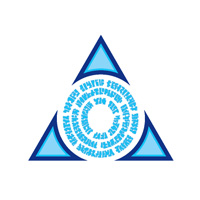 |
I am Azorius. I work to change the world into the world I believe it ought be. I believe that government can protect people from harmful elements in human nature and nongovernment organizations. Logic should temper passion, and so change should be slow precisely because we must understand that which is our desired end. |

